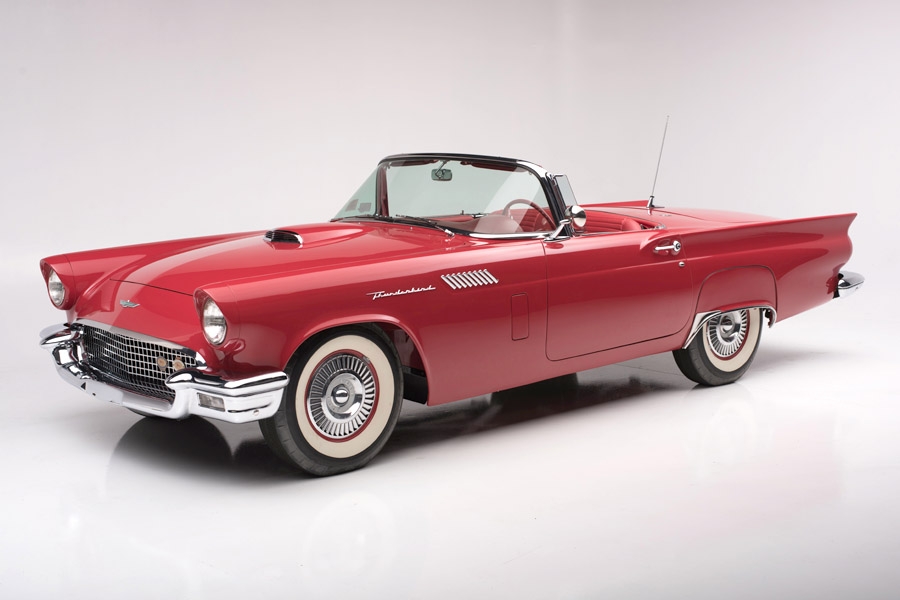SCM Analysis
Detailing
| Vehicle: | 1957 Ford Thunderbird F-code |
| Years Produced: | 1955–57 |
| Number Produced: | Approximately 212 F-code cars in 1957 |
| Original List Price: | $4,815 |
| SCM Valuation: | Median to date, $188,000; high sale, $247,500 |
| Tune Up Cost: | $300 |
| Distributor Caps: | $109 (NOS) |
| Chassis Number Location: | Passenger’s side cowl below hood-latch mechanism |
| Club Info: | Classic Thunderbird Club International |
| Website: | www.ctci.org |
| Alternatives: | 1957 Chevrolet Corvette fuel-injected, 1953 Cadillac Eldorado convertible, 1954 Kaiser-Darrin |
| Investment Grade: | B |
This car, Lot 386, sold for $193,900, including buyer’s premium, at Barrett-Jackson’s Palm Beach, FL, auction on April 9, 2016.
When the Beach Boys sang “She’ll have fun, fun, fun ’til her daddy takes the T-bird away…” what image came to mind? More than likely a beautiful young woman driving a ’50s two-seat Thunderbird.
Few automobiles have ever been so ingrained in popular culture as the original Thunderbird. They weren’t terribly popular when new — just 16,155 were built in 1955, 15,631 in ’56, and 21,380 in its final year (which ran until December 1957). The two-seater ’Bird was never marketed as a world-beating performance car, either, with advertising instead calling it “a personal car of distinction.”
While sales were hardly disappointing, the original Thunderbird was never the profit center that Ford’s data-driven Harvard “Whiz-Kid” general manager, Robert McNamara, had expected. For 1958, the classic two-seater was replaced with the much-maligned (but better selling) four-seater “Square Bird.”
McNamara didn’t quite grasp the image-building power a halo car can bring to a manufacturer, instead choosing to focus on the hard numbers. Yet from TV shows such as “Perry Mason” in the ’50s and “Vega$” in the ’80s, to movies like “American Graffiti” and “I Was a Teenage Werewolf,” to the Beach Boys’ hit song, all of which featured the car, it’s clear the original Thunderbird had substantial value in its status as a pop culture icon of the era.
Long-lived icon
That’s probably why the popularity of the 1955–57 Thunderbirds has never waned. It’s one of those rare automobiles that seems to ignore the ebb and flow of the marketplace. Just before the Great Recession of ’08 prices for these cars averaged $26,000 to $45,000; today they average $29,200 to $142,500, including the performance models Ford added in 1957: the 245-hp D-code and 270-hp E-code.
Then there is the legendary 300-hp supercharged F-code. The same engine was installed in a handful of Fairlane 500 sedans in 1957, which Ford used to counter Chevrolet’s fuel-injected Black Widows in NASCAR.
The first few of the F-birds were converted D-code cars (known as Code-D/F cars), which causes the list of F-code cars built to vary from expert to expert. Two of the supercharged cars were converted into full-fledged racers called “Battlebirds,” built to take on the competition at the 1957 Daytona Speed Weeks. The rest tended to be fully optioned street machines, which, like our feature F-code, represented the ultimate in ’50s two-seat personal luxury. Our very rare Flame Red example listed for $4,815.13 — big money when the average annual household income was around $5,000.
RM Auctions sold this same F-bird in 2006 for a smashing $319,000 (ACC# 43542) — far more than any other F-code sale recorded, and more than the $280,500 the only remaining “Battlebird” racer achieved at auction in 2010 (ACC# 165772). Certainly, color and quality were a factor in this sale, so why did it fetch a below-par $193,900 just a decade later? It could be that one or both sales were anomalies, with unique factors driving the price to record highs or disappointing lows for no particular reason. I hope that’s the case, but it could be something else entirely.
Buyers, values and the new market
Collectors tend to collect things from their past. Along those lines, baby boomers, born shortly after World War II, are most likely to collect items from the 1950s. In the same way, I doubt there are many collectors of “Star Wars” memorabilia who were born before, say, 1960.
Now those early boomers are downsizing their lives, or their estates are selling off their possessions, as we’ve seen happening with some large collections lately.
What will be the market for their ’57 Bel Air convertibles and F-code T-birds in the future? Later baby boomers like me tend to be more interested in ’60s muscle. And what about more recent generations? Some of them think of the Honda Civic and Toyota Supra — rather than the finned dinosaurs of the ’50s — as timeless classics. Of course, that could certainly affect values of cars like these when they come up for sale in the coming years. We’ll just have to wait and see. In the meantime, we need to monitor how the market for ’50s cars trends, and we also need to continue to work toward getting today’s youth more interested in collectible vehicles in general, the same way organizations such as SEMA are doing.
All that said, remember that it’s best not to underestimate the power of pop culture. Ford did it when these cars were new, and I think it’s still pretty safe to assume that the next generation of hardcore car collector can also sing most of the words to “Fun, Fun, Fun” without looking up the words on the Internet. There are undoubtedly a bunch of them just waiting for Daddy to hand those T-bird keys over — or to pick one up when it finally becomes available and they have the means to do so.
In the hierarchy of 1950s American classics, this blown Thunderbird has everything going for it, and all things considered, I’d call it exceedingly well bought at the price paid.
(Introductory description courtesy of Barrett-Jackson.)
